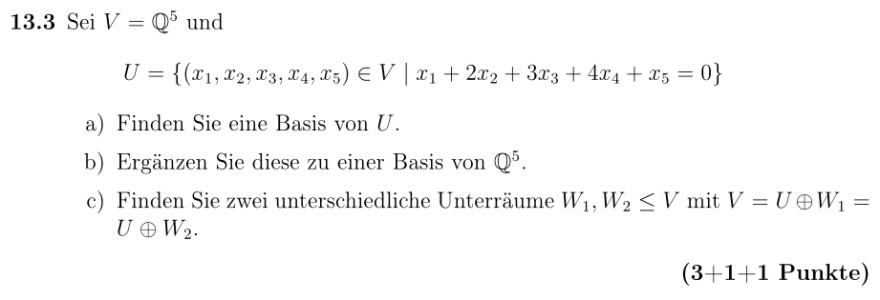Aufgabe: Das ist die Aufgabenstellung
Text erkannt:
13.3 Sei \( V=\mathbb{Q}^{5} \) und
\( U=\left\{\left(x_{1}, x_{2}, x_{3}, x_{4}, x_{5}\right) \in V \mid x_{1}+2 x_{2}+3 x_{3}+4 x_{4}+x_{5}=0\right\} \)
a) Finden Sie eine Basis von \( U \).
b) Ergänzen Sie diese zu einer Basis von \( \mathbb{Q}^{5} \).
c) Finden Sie zwei unterschiedliche Unterräume \( W_{1}, W_{2} \leq V \) mit \( V=U \oplus W_{1}= \) \( U \oplus W_{2} \).
\( (3+1+1 \) Punkte \( ) \)
Und folgende Lösung habe ich dazu ausgearbeitet: Hierbei bin ich mir bei a und b eigentlich relativ sicher, jedoch nicht bei c. Ich würde mich über Feedback freuen, ob diese Aufgabe so richtig gelöst ist und wenn es falsch ist, wie es richtig sein müsste

Text erkannt:
Aufgabe 13.3 sei \( V=\mathbb{Q}^{5} \quad U^{-}\left\{\left(x_{1}, x_{2}, x_{3}, x_{4}, x_{5}\right) \in V \mid x_{1}+2 x_{2}+3 x_{3}+4 x_{4}+x_{5}=0\right\} \)
a) gesucht Basis von 4 :
\( \begin{array}{l} x_{1}+2 x_{2}+3 x_{3}+4 x_{4}+x_{5}=0 \Rightarrow x_{1}=-2 x_{2}-3 x_{3}-4 x_{4}-x_{5} \quad\left(x_{2}, x_{3}, x_{4}, x_{5} \text { frei wählubas }\right) \\ \Rightarrow u=\left\{\left(\begin{array}{c} -2 x_{2}-3 x_{3}-4 x_{4}-x_{5} \\ x_{2} \\ x_{3} \\ x_{4} \\ x_{5} \end{array}\right)=x_{2}\left(\begin{array}{c} -2 \\ 1 \\ 0 \\ 0 \\ 0 \end{array}\right)+x_{3}\left(\begin{array}{l} -3 \\ 0 \\ 1 \\ 0 \\ 0 \end{array}\right)+x_{4}\left(\begin{array}{c} -4 \\ 0 \\ 0 \\ 1 \\ 0 \end{array}\right)+x_{5}\left(\begin{array}{c} -1 \\ 0 \\ 0 \\ 0 \\ 1 \end{array}\right) ; x_{2}, x_{3}, x_{4} x_{5} \in \mathbb{R}\right\} \\ u=\left\langle\left(\begin{array}{c} -2 \\ 0 \\ 0 \end{array}\right),\left(\begin{array}{c} -3 \\ 0 \\ 0 \\ 0 \end{array}\right),\left(\begin{array}{c} -4 \\ 0 \\ 0 \\ 1 \\ 0 \end{array}\right),\left(\begin{array}{c} -1 \\ 0 \\ 0 \\ 1 \end{array}\right)\right\rangle \text { mit Basis }\left\{\left(\begin{array}{c} -2 \\ 1 \\ 0 \\ 0 \\ 0 \end{array}\right),\left(\begin{array}{c} -3 \\ 0 \\ 1 \\ 0 \\ 0 \end{array}\right),\left(\begin{array}{c} -4 \\ 0 \\ 0 \\ 1 \\ 0 \end{array}\right),\left(\begin{array}{c} -1 \\ 0 \\ 0 \\ 0 \\ 1 \end{array}\right)\right\} \text { von U } \end{array} \)
b) un die Basis aus a auf \( \mathbb{Q}^{5} \) zu crgänzon brauchen wir einen l.u. Vektor von deu 4 Basisvekocen
\( \begin{array}{l} \text { Angenommen dies sei : } v=\left(\begin{array}{l} 1 \\ 0 \\ 0 \\ 0 \\ 0 \end{array}\right) \quad \text { Probe: }\left(\begin{array}{l} 1 \\ 0 \\ 0 \\ 0 \\ 0 \end{array}\right)+x_{2}\left(\begin{array}{l} -2 \\ 0 \\ 1 \\ 0 \\ 0 \end{array}\right)+x_{3}\left(\begin{array}{c} -3 \\ 0 \\ 1 \\ 0 \\ 0 \end{array}\right)+x_{4}\left(\begin{array}{c} -4 \\ 0 \\ 0 \\ 1 \\ 0 \end{array}\right)+x_{5}\left(\begin{array}{c} -1 \\ 0 \\ 0 \\ 1 \end{array}\right)=\left(\begin{array}{l} 0 \\ 0 \\ 0 \\ 0 \end{array}\right) \\ x_{1}-2 x_{2}-3 x_{3}-4 x_{4}-x_{5}=0=0 x_{1}-2 \cdot 0-3 \cdot 0-4 \cdot 0-1 \cdot 0=0 \\ x_{2}=0 \quad \Rightarrow x_{1}=0 \\ x_{3}=0 \\ x_{4}=0 \\ x_{5}=0 \\ \Rightarrow x_{1} \cdot x_{2} \cdot x_{3}=x_{4} \cdot x_{5}=0 \quad x \text { l.u. } \\ \Rightarrow \text { Basis von } U \text { in } \mathbb{Q}^{5}:\left\{\left(\begin{array}{l} 1 \\ 0 \\ 0 \\ 0 \\ 0 \end{array}\right),\left(\begin{array}{c} -2 \\ 1 \\ 0 \\ 0 \\ 0 \end{array}\right),\left(\begin{array}{c} -3 \\ 0 \\ 1 \\ 0 \\ 0 \end{array}\right),\left(\begin{array}{c} -4 \\ 0 \\ 0 \\ 1 \\ 0 \end{array}\right),\left(\begin{array}{c} -1 \\ 0 \\ 0 \\ 0 \\ 1 \end{array}\right)\right\} \\ \end{array} \)
c) Fis \( \omega_{1} \) und \( \omega_{2} \) benätigen wès juceils einuen Vektor wällen duc l.u. zus Basis von \( U \) ist aber \( v \neq(\hat{g}) \) (da schon füs \( b \) verwemolet)
a.B. wäen \( \omega_{1}=\left(\begin{array}{l}0 \\ 0 \\ 0 \\ 0\end{array}\right) \) und \( \omega_{2}=\left(\begin{array}{l}0 \\ 0 \\ 1 \\ 0 \\ 0\end{array}\right) \) solche veltoren, womit die \( U R \) whet \( \omega_{2} \) wie folgt defeniest sind: \( \left.W_{1}=\left\{\begin{array}{l}0 \\ 0 \\ 0 \\ 0 \\ 0\end{array}\right)\right\} \) und \( \omega_{2}=\left\{\left(\begin{array}{l}0 \\ 0 \\ 0 \\ 0 \\ 0\end{array}\right)\right\} \)
\( \Rightarrow \) somit gilt \( v-u \oplus W_{1}=u \oplus W_{2} \), da jeder Vektor in \( \mathbb{Q}^{5} \) eindeutig als Linearkambination von einem Velitor aus \( U \) und einem Veletor aus \( w_{1} \) baw. \( w_{2} \).